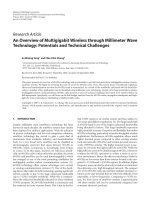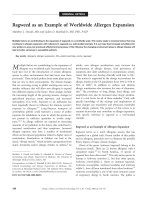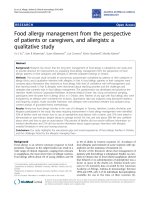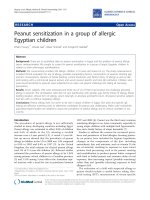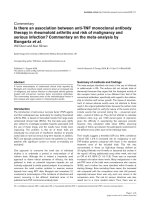Báo cáo y học: "Peanut Allergy: An Overview" doc
Bạn đang xem bản rút gọn của tài liệu. Xem và tải ngay bản đầy đủ của tài liệu tại đây (100.86 KB, 5 trang )
Allergy, Asthma, and Clinical Immunology, Vol 4, No 4 (Winter), 2008: pp 139–143 139
ORIGINAL ARTICLE
Peanut Allergy: An Overview
Nasser Al- Ahmed, MD, Shirina Alsowaidi, MD, and Peter Vadas, MD, PhD
Peanut allergies have been increasing in prevalence in most industrialized countries. Onset is typically in early childhood, with a trend towards earlier
ages of presentation. The allergy is lifelong in most affected children, although 15–22% will outgrow their peanut allergy, usually before their teenage
years. Manifestations of peanut allergy range from mild to severe, and risk factors predisposing to severe reactions are discussed. However, even in
the absence of risk factors, peanut allergic individuals may still experience life- threatening anaphylactic reactions. Approaches to investigation and
treatment, patterns of cross- reactivity and possible causes of rising prevalence are discussed.
Key words: peanut, allergy, anaphylaxis, nuts
challenges, the total estimate for clinical peanut allergy was
.% of - to - year- old children. The results from those two
studies are suggestive of an overall increase in the prevalence
of peanut allergy among children. Another study estimated
the prevalence of peanut allergy to be .% among primary
school children in a Canadian province.
Clinical Reactions to Peanuts
Allergies to peanut have a spectrum of clinical presentations
ranging from cutaneous manifestations to life- threatening sys-
temic reactions. Symptoms usually develop within minutes af-
ter ingestion of even a trace amount of peanut and may involve
cutaneous, cardiovascular, gastrointestinal, genitourinary,
and / or respiratory systems. Progressive upper or lower respi-
ratory symptoms, hypotension, and arrhythmias typically de-
velop in fatal and near- fatal cases. Factors that appear to
contribute to a fatal outcome include a concomitant diagnosis
of asthma, a delay in the administration of epinephrine, pre-
vious severe allergic reactions to peanut, and not recognizing
the presence of peanut in the meal. Initial reactions occur at
the rst apparent exposure in % of patients, with a median
age of months, and most reactions occur in the home.
In this study, % of initial reactions involved the skin, %
the respiratory tract, and % the gastrointestinal tract. Two
organ systems were aected in % of reactions, and all three
systems were aected in %. Moreover, subsequent acciden-
tal reactions occurred in % of peanut- allergic patients over a
median period of . years with similar symptoms. This illus-
trates the diculty of strict avoidance of this ubiquitous food
product even in those patients compliant with the recommen-
dations made by treating physicians. Patients with isolated
cutaneous manifestations had lower serum peanut- specic
IgE levels than the group with respiratory and / or gastro-
intestinal symptoms, with a median of . kUA / L versus
. kUA / L. However, despite this, there was no threshold
level below which only skin manifestations appeared to occur.
F
ood allergy is a common problem encountered by pri-
mary care physicians. It is estimated to aect to % of
children and to % of adults and is considered a major cause
of life- threatening hypersensitivity reactions.
–
Eight foods are
responsible for more than % of food allergies: cow’s milk,
egg, soy, wheat, peanut, tree nuts, sh, and shellsh.
Among
those foods, peanut has attracted considerable attention for
several reasons. Peanut allergy is common, typically with on-
set in the rst few years of life. Allergy to peanut usually is
lifelong and accounts for most of the food- induced severe and
fatal allergic reactions.
Hence, the diagnosis of peanut allergy
carries with it considerable medical and emotional signicance.
Prevalence
The prevalence of anaphylaxis from all causes is rising, but
food- induced anaphylaxis is causing a disproportionate in-
crease in the rates of anaphylaxis. A recent study in the
United States assessed the prevalence of peanut allergy by
random telephone survey. The prevalence of peanut allergy
was estimated to aect .% of children and .% of adults,
showing a twofold increase over a - year period. In the Isle
of Wight, United Kingdom, a study was conducted on a birth
cohort of - and - year- old children born between and
, and the results were compared with those of a cohort
born in . There was a documented twofold increase in
reported peanut allergy (.–.%) and a threefold increase
in sensitization, and after further analysis that included oral
Nasser Al- Ahmed, Shirina Alsowaidi, and Peter Vadas: Division of Allergy
and Clinical Immunology, St. Michael’s Hospital, University of Toronto,
Toronto, ON.
Correspondence to: Peter Vadas, MD, Division of Allergy and Clinical
Immunology, Carter Wing, Room 8-161, St. Michael’s Hospital, 30 Bond St.,
Toronto, ON M5B 1W8; e- mail:
© The Canadian Society of Allergy, Asthma and Clinical Immunology
DOI . / ..
140 Allergy, Asthma, and Clinical Immunology, Volume 4, Number 4, 2008
Cosensitization to tree nuts is also common, although
the cross- reacting proteins are not yet known. The rate of co-
allergy varies from .% in one survey to as high as approxi-
mately one- third of peanut- allergic patients. There is a high
degree of cosensitization with seeds.
Theories on Why the Prevalence of Peanut Allergy
Is Increasing
It remains unclear why the prevalence of peanut allergy is ris-
ing in the Western world. Multiple theories have tried to ex-
plain the overall increase in the prevalence of allergic diseases
in the Western world over the last decade, mainly describing
an imbalance between the T- helper (Th) / T- helper (Th)-
biased cellular responses in early life. Other theories have
been advanced to explain the rise of peanut allergy. The ma-
jor peanut allergens have been detected in the breast milk of
lactating women. This occult exposure through breast milk
from mothers ingesting peanut during lactation may sensitize
the infants to peanut and thus explain the occurrence of al-
lergic reactions to peanut on rst exposure in the majority of
children. Alternatively, exposure of infants to peanut protein
via breast milk in the perinatal period may aid in the develop-
ment of immunologic tolerance in some infants.
The methods by which peanuts are prepared may contrib-
ute to the increase prevalence of peanut allergy in the West-
ern hemisphere. Peanuts are prepared mainly by dry roasting,
including peanuts that are made into peanut butter. Roasting
has been shown to alter both the structure and the allergenic-
ity of peanut. Dry roasting also induces functional altera-
tions by causing a .- fold increase in the function of Ara h,
which acts as a trypsin inhibitor protecting Ara h from pro-
teolytic digestion. Lack and colleagues found an association
between peanut allergy in preschool- age children and a family
history of peanut allergy, consumption of soy during infancy,
early onset of eczema, other rashes with oozing and crust-
ing, and exposure to topical preparations containing peanut
oil. The latter are present in the form of emollients for the
treatment of diaper rash, eczema, dry skin, and inammatory
cutaneous conditions during infancy.
Other Names and Common Sources of Hidden
Peanut Products
Warnings and educational brochures about allergy to pea-
nuts are distributed by the Canadian Food Inspection Agency
(<http: // www .inspection.gc .ca>). Peanuts may be manufac-
tured under other names, including arachis oil, beer nuts,
cacahouette, goober nuts or peas, ground nuts, mandelonas,
nu- nuts, nut meats, and valencias.
Possible hidden sources of peanut exposure include almond
Diagnosis
The evaluation of a child with suspected allergy to peanut
should include a careful history taking, skin- prick testing,
measurement of serum- specic IgE, and, possibly, an oral
food challenge. The use of ImmunoCAP, a serologic test,
can be both diagnostic and prognostic as a peanut- specic
serum IgE level of kUA / L or higher has a % predictive
value for an allergic reaction on ingestion of peanut. Patients
developing typical allergic symptoms after the isolated inges-
tion of peanut protein who have evidence of peanut- specic
IgE antibodies, that is, by a positive skin- prick test and / or
ImmunoCAP, do not need to undergo a conrmatory oral
challenge.
Skin testing is generally relied on for diagnosis. A wheal
mm greater than the negative control is considered a posi-
tive reaction. Overall, a negative skin- prick test to peanut
has a negative predictive value of more than %. The posi-
tive predictive value, however, is signicantly lower, reaching
only % in patients with a convincing history of an allergic
reaction. A recent study showed that a positive skin- prick
test with a wheal diameter of mm or more had a predictive
value of % (% condence interval .–.) for a posi-
tive challenge.
For acute allergic reactions, the diagnosis is based on clin-
ical symptoms, a history of exposure to relevant allergen, and
supportive skin- prick tests and / or ImmunoCAP test. Serum
β- tryptase level, considered the hallmark of mast cell activa-
tion, may not be helpful since it can be normal in patients with
food- induced anaphylaxis.
The three major allergenic proteins in peanut are Ara h,
h, and h.
Cross- Reactivity with Other Foods
Peanut belongs to the plant family Leguminosae. The legume
family also includes soybeans, peas, lima beans, green beans,
other beans, chickpeas, and lentils. The fact that they are low
in fat, contain no cholesterol, and are high in protein, folate,
potassium, iron, and magnesium has contributed to their
widespread consumption in the North American diet.
Barnett and colleagues demonstrated a high rate of cross-
reactivity between peanut and legumes when they screened
sera from patients with peanut allergy against other
legumes. There was demonstrable IgE binding to multiple
legumes in % of patients. However, clinical cross- reactions
are uncommon. In a study of children with peanut allergy
conrmed by a double- blinded, placebo- controlled oral food
challenge, (%) had a positive skin- prick test response to
soy, but only (%) had a clinical reaction to soy and another
to pea.
Al- Ahmed et al, Peanut Allergy 141
gredient labels when purchasing prepackaged foods, inform
the school authorities about the presence of allergy to peanuts,
and develop an action plan to be implemented in the event
of an allergic emergency. There are multiple reliable online
resources for families and patients in need of further informa-
tion, some of which are included in Table .
In the acute setting, patients and family members are ad-
vised to inject epinephrine early during the course of the re-
action as this has been shown not only to reduce the risk of
a fatal outcome but also to reduce the likelihood of a bi-
phasic reaction. Asthma, especially when poorly controlled,
is a recognized risk factor for near- fatal or fatal anaphylaxis.
In individuals at risk for anaphylaxis, it is crucial to stress
the need to ensure that asthma remains well controlled at all
times. Patients and parents are always instructed to go to the
nearest emergency department if they or their child develops a
systemic reaction and / or need to use injectable epinephrine.
Therapies under Investigation
Some therapeutic modalities are currently under investiga-
tion and show considerable promise. These include monoclo-
nal anti- IgE, oral peanut desensitization and immunotherapy,
Chinese herbal formulas, probiotics, and heat- killed Listeria
monocytogenes (HKL).
Anti- IgE
Allergic reactions are mediated by antigen- specic IgE bound
to high- anity receptors (FcεRI) on mast cells and baso-
phils. TNX- is a humanized IgG monoclonal antibody
against IgE that binds with high anity to an epitope in the
CH domain, masking a region responsible for binding to
FcεRI. Leung and colleagues divided patients with peanut
allergy into four groups: a placebo arm and three active treat-
ment groups receiving either , , or mg of TNX-
subcutaneously every weeks for four doses. Several
and hazelnut paste, icing, glazes, marzipan, and nougat; arti-
cial nuts (peanuts that have been altered to look and taste like
almonds, pecans, and walnuts); baked goods (cakes, cookies,
doughnuts, pastries); cereals; chili; cross- contamination (con-
tainers, foods deep fried in oil, utensils); desserts (frozen des-
serts, frozen yogurts, ice cream, sundae toppings); dried salad
dressing, soup mix; ethnic foods (including sauces and soups);
fried foods; gravy; hydrolyzed plant protein / vegetable protein;
peanut oil; snack foods (candy, chocolate, dried fruits, energy /
granola bars, mixed nuts, popcorn, potato chips, trail mixes);
and vegetarian meat substitutes. Nonfood sources containing
peanut protein include ant baits, bird feed, mouse traps, and
pet food; cosmetics; sunscreens; craft materials; medications;
vitamins; mushroom- growing medium; and stung in toys.
Outgrowing Peanut Allergy
In comparison to allergy to milk and egg, it was tradition-
ally thought that allergy to peanut is rarely outgrown. How-
ever, one study has shown that peanut allergy can be out-
grown in as many as .% of patients. In another study,
patients with a history of peanut allergy could successfully
pass their oral challenge with peanut according to their se-
rum peanut- specic IgE level. More specically, % of chil-
dren with a peanut- specic IgE of kUA / L or less, % with
a peanut- specic IgE of kUA / L or less, and % with an un-
detectable peanut- specic IgE passed an oral challenge with
peanut. These data suggest that patients with a history of
peanut allergy and a peanut- specic IgE level of or less have
at least a % chance of outgrowing their allergy. This infor-
mation, along with the details of previous clinical reactions
and the results of ongoing allergic evaluation, can then be
used to stratify current risk and prognosticate. Also, parents
and patients need to know that there is a possibility of resen-
sitization after a negative prick skin test (PST) and negative
challenge, especially in the absence of regular intake.
Management
Management of peanut allergy is based mainly on
1. Educating patients and families to avoid peanuts and
peanut- containing products
2. Awareness of early signs of an allergic reaction result-
ing from accidental exposure
3. Education on the proper use of self- injectable epineph-
rine (eg, Twinject or EpiPen autoinjectors)
Patients and caregivers of a child with peanut allergy, includ-
ing parents, teachers, babysitters, daycare workers, and other
family members, must be instructed to carefully read all in-
Table 1. Online Resources for Families and Patients in Need of Further
Information about Peanut Allergy
Name of Organization Website
Anaphylaxis Canada http: // www .anaphylaxis .ca
Allergy Asthma Information
Association
http: // www .aaia .ca
The Food Allergy and Anaphylaxis
Network
http: // www .foodallergy .org
American College of Allergy, Asthma
and Immunology
http: // www .acaai .org
American Academy of Allergy,
Asthma and Immunology
http: // www .acaai .org
Food You Can Eat http: // www .foodyoucaneat .com
Association Québécoise des Allergies
Alimentaires
http: // www .aqaa.qc .ca
142 Allergy, Asthma, and Clinical Immunology, Volume 4, Number 4, 2008
ducted a prospective study dividing newborn infants into two
groups receiving either the probiotic Lactobacillus rhamnosus
strain GG (ATCC ) or placebo. At years of age, there
was a signicant decrease in the prevalence of atopic derma-
titis (AD) in the Lactobacillus treatment group, suggesting a
role for probiotics in the prevention of the development of AD.
However, the number of children with allergic rhinitis and
asthma did not dier between the two groups, although the
concentration of exhaled nitric oxide, considered a marker of
bronchial inammation, was signicantly greater in children
receiving placebo than in those receiving Lactobacillus. When
added in vitro, probiotics resulted in enhanced production
of IFN- γ, interleukin (IL)- , and tumour necrosis factor α.
However, oral administration of probiotics to children with
food allergy, some of whom were allergic to peanut, is associ-
ated with a decrease in IgE production in vitro. This may
support a role for probiotics in protecting against or amelio-
rating the allergy to peanut, although this is still experimental.
Heat- Killed Listeria
HKL is a potent stimulator of the innate immune system.
Yeung and colleagues found that mice immunized with
keyhole- limpet hemocyanin (KLH) mixed with HKL devel-
oped a reversion of the established immune responses domi-
nated by the production of Th cytokines and high levels of
KLH- specic IgE. Treatment with HKL induced a Th- type
response with high levels of IFN- γ and IgGa and low KHL
levels of IgE and IL- . These results suggest that use of HKL
as an adjuvant during immunization can successfully bias the
development of antigen- specic cytokine synthesis toward
Th cytokine production even in the setting of an ongoing
Th- dominated response. Frick and colleagues found KHL
subcutaneous vaccination with peanut allergen and HKL in-
creased the threshold for peanut allergen–induced skin reac-
tions and symptoms in peanut- allergic dogs. Similar data
have not yet been developed in humans, and the safety of this
approach in human remains unclear.
Summary
Peanut allergy continues to be a major health- related issue
worldwide, with many theories advanced to explain this ap-
parent rise in prevalence. Manifestations of peanut allergy
may be life- threatening and require an aggressive approach to
risk factor modication and management, with emphasis on
prevention and the early use of injectable epinephrine. Mul-
tiple novel therapeutic options are under investigation with
considerable prospects for successful modication of a com-
mon, potentially fatal condition.
weeks after completing the study, patients on the higher dose
of anti- IgE therapy had a signicant increase in the thresh-
old of sensitivity to peanut by oral food challenge, from one
peanut ( mg) to almost nine peanuts (, mg). Despite
the short duration of the study, one would predict that inde-
nite administration of anti- IgE is needed to maintain a state
of relative tolerance.
Immunotherapy and DNA Immunization
Oppenheimer and colleagues conducted a trial of rush injec-
tion immunotherapy for the treatment of anaphylactic sensi-
tivity to peanut. Patients in the treatment group were able
to tolerate increased amounts of peanut in food challenges
after treatment. Unfortunately, there was a high rate of ad-
verse systemic reactions, including a case of fatal anaphylaxis,
associated with the treatment group compared with the group
receiving placebo.
Another approach makes use of deoxyribonucleic acid
(DNA) immunization. DNA immunization employs the
subcutaneous injection of a plasmid DNA vector encoding
a specic allergenic protein. After uptake and processing by
antigen- presenting cells, it is presented to T cells in the con-
text of the major histocompatibility complex. This approach is
thought to induce a Th phenotypic response with upregula-
tion of interferon (IFN)- γ, an increase in IgGa, and suppres-
sion of allergen- specic IgE production. This approach has
thus far been used in murine models and has yet to be applied
to human subjects.
Chinese Herbal Formula
A herbal formula called Food Allergy Herbal Formula
(FAHF)- was previously reported to block systemic ana-
phylactic in mice sensitized to peanut protein. It does so
by reducing mast cell degranulation and histamine release,
peanut- specic serum IgE level, and Th cytokine secretion.
A subsequent report used a rened herbal formula, FAHF- ,
produced after exclusion of two herbs from the original for-
mula. Peanut- sensitized mice pretreated with FAHF- for
weeks had no signs of anaphylaxis following peanut chal-
lenge , , and weeks posttherapy. It was concluded that
FAHF- treatment protected against active anaphylaxis in
peanut- allergic mice. However, this herbal formula has not
yet been studied in humans for safety and ecacy.
Probiotics
Probiotics are bacterial components that enhance the host’s
intestinal microbial balance. Kalliomaki and colleagues con-
Al- Ahmed et al, Peanut Allergy 143
23. Teuber SS, Beyer K. Peanut, tree nut and seed allergies. Curr Opin Al-
lergy Clin Immunol 2004;4:201–3.
24. Vandenbulke L, Bachert C, van Cauwenberg P, Claeys S. The innate
immune system and its role in allergic disorders. Int Arch Allergy
Immunol 2005;139:159–65.
25. Vadas P, Wai Y, Burks W, Perelman B. Detection of peanut allergens in
breast milk of lactating women. JAMA 2001;285:1746–8.
26. Maleki SJ, Viquez O, Jacks T, et al. The major peanut allergen, Ara h 2
functions as a trypsin inhibitor and roasting enhances this function.
J Allergy Clin Immunol 2003;112:175–9.
27. Lack G, Fox D, Northstone K, Golding J. N Engl J Med 2003;348:
977–85.
28. Adopted from consumer fact sheet about peanuts, a product of The
Canadian Food Inspection Agency.
29. Skolnick HS, Conover- Walker MK, Koerner CB, et al. The natural his-
tory of peanut allergy. J Allergy Clin Immunol 2001;107:367–74.
30. Fleischer DM, Conover- Walker MK, Christie L, et al. The natural pro-
gression of peanut allergy: resolution and the possibility of recurrence.
J Allergy Clin Immunol 2003;112:183–9.
31. Kerr P. Peanut resensitization after negative skin tests and negative oral
challenge. J Allergy Clin Immunol 2004;113:S151.
32. Sampson HA, Mendelson L, Rosen JP. Fatal and near- fatal anaphy-
lactic reactions to food in children and adolescents. N Engl J Med
1992;327:380–4.
33. Lieberman P. Biphasic anaphylactic reactions. Ann Allergy Asthma
Immunol 2005;95:217–26.
34. Bock SA, Munoz- Furlong A, Sampson HA. Fatalities due to anaphylac-
tic reactions to foods. J Allergy Clin Immunol 2001;107:191–3.
35. Kinet JP. The high- anity IgE receptor (Fc epsilon RI): from physiology
to pathology. Annu Rev Immunol 1999;17:931–72.
36. Leung DY, Sampson HA, Yunginger JW, et al. Eect of anti- IgE therapy
in patients with peanut allergy. N Engl J Med 2003;348:986–93.
37. Oppenheimer JJ, Nelson HS, Bock SA, et al. Treatment of peanut allergy
with rush immunotherapy. J Allergy Clin Immunol 1992;90:256–62.
38. Pons L, Palmer K, Burks W. Towards immunotherapy for peanut allergy.
Curr Opin Allergy Clin Immunol 2005;5:58–62.
39. Li XM, Zhang TF, Huang CK, et al. Food Allergy Herbal Formula- 1
(FAHF- 1) blocks peanut- induced anaphylaxis in a murine model.
J Allergy Clin Immunol 2001;108:639–46.
40. Srivastava KD, Kattan JD, Zou ZM, et al. The Chinese herbal medicine
formula FAHF- 2 completely blocks anaphylactic reactions in a murine
model of peanut allergy. J Allergy Clin Immunol 2005;115:171–8.
41. Kalliomaki M, Salminen S, Poussa T, et al. Probiotics and prevention
of atopic disease: 4- year follow- up of a randomised placebo- controlled
trial. Lancet 2003;361:1869–71.
42. Yeung VP, Gieni RS, Umetsu DT, DeKruy RH. Heat- killed List-
eria monocytogenes as an adjuvant converts established murine Th2-
dominated immune responses into Th1- dominated responses. J Immu-
nol 1998;161:4146–52.
43. Frick OL, Teuber SS, Buchanan BB, et al. Allergen immunotherapy with
heat- killed Listeria monocytogenes alleviates peanut and food- induced
anaphylaxis in dogs. Allergy 2005;60:243–50.
44. Flinterman AE, Knol EF, van Ieperen- van Dijk AG, et al. Probiotics
have a dierent immunomodulatory potential in vitro versus ex vivo
upon oral administration in children with food allergy. Int Arch Allergy
Immunol 2007;143:237–44.
References
1. Bock SA. Prospective appraisal of complaints of adverse reactions to
foods in children during the rst 3 years of life. Pediatrics 1987;79:
683–8.
2. Jansen JJ, Kardinaal AF, Huijbers G, et al. Prevalence of food allergy
and intolerance in the adult Dutch population. J Allergy Clin lmmunol
1994;93:446–56.
3. Young E, Stoneham MD, Petruckevitch A, et al. A population study of
food intolerance. Lancet 1994;343:1127–30.
4. Hee SL, Nordlee JA, Taylor SL. Allergenic foods. Crit Rev Food Sci
Nutr 1996;36:S69–89.
5. Sicherer SH, Sampson HA. Peanut and tree nut allergy. Curr Opin
Pediatr 2000;12:567–73.
6. Hourihane JO. Peanut allergy- current status and future challenges. Clin
Exp Allergy 1997;27:1240–5.
7. Sheikh A, Alves B. Hospital admissions for acute anaphylaxis: time
trend study. BMJ 2000;320:1441.
8. Sicherer SH, Munoz- Furlong A, Sampsom HA. Prevalence of peanut
and tree nut allergy in the United States determined by means of a ran-
dom digit dial telephone survey: a 5- year follow- up study. J Allergy Clin
Immunol 2003;112:1203.
9. Sicherer SH, Munoz- Furlong A, Burks AW, Sampson HA. Prevalence of
peanut and tree nut allergy in the US determined by a random digit dial
telephone survey. J Allergy Clin Immunol 1999;103:559–62.
10. Grundy J, Matthews S, Bateman B, et al. Rising prevalence of allergy
to peanut in children: data from 2 sequential cohorts. J Allergy Clin
Immunol 2002;110:784–9.
11. Kagan RS, Joseph L, Dufresne C, et al. Prevalence of peanut allergy in
primary- school children in Montreal, Canada. J Allergy Clin Immunol
2003;112:1223–8.
12. Sampson HA. Peanut allergy. N Engl J Med 2002;346:1294–9.
13. Sicherer SH, Burks AW, Sampson HA. Clinical features of acute allergic
reactions to peanut and tree nuts in children. Pediatrics 1998;2:364.
14. Vander Leek TK, Liu AH, Stefanski K, et al. The natural history of peanut
allergy in young children and its association with serum peanut- specic
IgE. J Pediatr 2000;137:749–55.
15. Sampson HA, Ho DG. Relationship between food- specic IgE concen-
trations and the risk of positive food challenges in children and adoles-
cents. J Allergy Clin Immunol 1997;100:444–51.
16. Bock SA, Buckley J, Holst A, May CD. Proper use of skin tests with
food extracts in diagnosis of hypersensitivity to food in children. Clin
Allergy 1977;7:375–83.
17. Sampson HA, Albergo R. Comparison of results of skin tests, RAST,
and double blinded placebo- controlled food challenges in children with
atopic dermatitis. J Allergy Clin Immunol 1984;74:26.
18. Roberts G, LackG. Diagnosing peanut allergy with skin prick and spe-
cic IgE testing. J Allergy Clin Immunol 2005;115:1291–6.
19. Lin RY, Schwartz LB, Curry A, et al. Histamine and tryptase levels in
patients with acute allergic reactions: an emergency department- based
study. J Allergy Clin Immunol 2000;106:65–71.
20. Burks W, Sampson HA, Bannon GA. Peanut allergens. Allergy 1998;
53:725–30.
21. Barnett D, Bonham B, Howden ME. Allergenic cross- reactions among
legume foods—an in vitro study. J Allergy Clin Immunol 1987;79:
433–8.
22. Bock SA, Atkins FM. The natural history of peanut allergy. J Allergy
Clin Immunol 1989;83:900–4.


